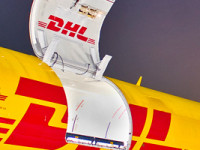Deutsche Post-DHL reported second-quarter net income up 66.0% y-o-y to €541 million, a sound indicator the company’s restructuring plans are beginning to have the desired effect. Total revenue declined 3.5% to €14.19 billion (see chart at right). Operating profit (EBIT) for the quarter was up 40.0% to €752 million. For the first half of 2016 DP-DHL reported net income up 43.7% to €1.18 billion and EBIT up 29.3% to €1.63 billion, with the gains coming despite a 4.8% decrease in revenue to €28.06 billion. The company said the decline in revenue was the result of changes in a contract with the UK National Health Service combined with negative currency effects.
Companywide, each of DP-DHL’s four operating divisions reported significant increases in operating profit during the first half, even as revenues for all divisions except Post and Express (which were nearly flat) declined. Now for a closer looking at each division’s performance:
Post-eCommerce-Parcel: Revenue from postal operations was up 1.0% in the first half, driven by higher package volumes and three extra working days. The shining light in the division however, was the eCommerce – Parcel unit which saw revenues jump 11.3%. Overall EBIT for the division was up 39.0%.
Express: The DHL Express division continued its strong performance, with revenue up 1.2% in the first half to €6.77 billion, despite negative currency effects. The revenue growth was strongest in the Americas region, up 6.5%. CFO Larry Rosen said DHL Express has made market share gains “across all regions” as the trend of “rising, high-value, cross-border B2C volumes” continued to supplement existing B2B volumes. Express EBIT was up 9.7% in the half to €777 million, and operating margin rose 0.9 percentage points to 11.5%.
Global Forwarding: Freight: Revenue in the division dropped 10.8% in the first half, impacted by negative currency effects, lower fuel surcharges, and “the generally low level of air and ocean freight rates. Air freight volume fell 7.7% in the half to 1.7 million tonnes, although ocean freight volume was up 2.8% to 1.5 million TEUs. DHL said lower airfreight volumes resulted from the division’s “selective stance” on profitable volumes and a decline in demand from the oil & gas sector. This strategy, despite the fall in revenue and tonnage, has pushed divisional EBIT up 110% to €120 million, as turnaround measures instituted after the New Forwarding Environment disaster began to take effect.
Supply Chain: In the Supply Chain division first-half revenue was down 13.2% to €6.93 billion, but EBIT was up 33.1% to €229 million. EBIT received a one-off boost from the proceeds received from the sale of a stake in King’s Cross which the division used to finance restructuring expenses of €41 million during the first half. Rosen said the division also saw “an increase in new signings” noting that “retail, consumer and automotive continued to be the biggest sectors for the division.”
Looking forward, the company will to hone-in its focus on e-commerce, what it refers to as a “megatrend” expected to continue to drive volume and revenue growth. Last week, the company’s eCommerce – Parcel unit announced major investments into new distribution centers in the United States aimed at capturing the growing market for cross-border e-commerce. In addition to upgrading existing fulfillment centers in Los Angeles and Columbus, it will add six new centers in New Jersey and other cities throughout the United States to complement its 18 existing distribution centers.

